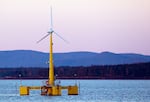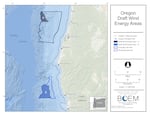A push to bring floating offshore wind technology to the Southern Oregon coast was gaining momentum.
The Oregon Department of Energy saw floating offshore wind playing a critical role in the state’s — and the region’s — renewable energy goals. The Biden administration had ambitious national goals for developing offshore wind, and the Oregon Coast played a key role. For the U.S. Department of Interior’s Bureau of Ocean Energy Management, or BOEM, the years-long process of identifying areas for development and selecting potential bidders to see if the technology would work off the coast was coming to a close.
And then, in a single week in late September — after years of effort, and less than three weeks before BOEM officials expected to choose a company to develop offshore wind — everything fell apart.
Tribes sued, seeking a delay and more information on impacts. Developers backed out. Oregon Gov. Tina Kotek raised concerns. And on Friday, Sept. 27, BOEM called everything off.
Some say it was a combination of many factors — including upfront costs, a lack of market, concerns from local impacted residents, and a lack of state-level support — that led BOEM to cancel its October auction.

A computer-generated representation of a floating offshore wind turbine. The Bureau of Ocean Energy Management planned to auction off sites off the Southern Oregon coast to develop this technology, but has postponed those plans indefinitely.
Courtesy of Bureau Of Ocean Energy Management
“We weren’t surprised at all,” Renewable Northwest’s executive director Nicole Hughes said. “We had been hearing for some time from the offshore wind industry that the pieces just weren’t in place for Oregon to have a competitive auction. So, we weren’t surprised that it was canceled. We’re not surprised that there has been continued opposition from the coast as well.”
For Oregon to meet its greenhouse gas emission reduction goals, advocates and researchers say the state will need to add more renewable energy sources. Floating offshore wind could be part of that solution. But for the technology to succeed, experts say, the state will need federal support as well as mandates that require utilities to procure their electricity and provide the public with credible information about the impacts of the technologies.
National politics overshadow local opposition
Renewable Northwest’s Hughes, whose group has been part of the offshore wind conversation for the past two years, said many things led to BOEM postponing the auction. A big factor was the upcoming presidential election.
“From what we heard leading up to this decision, from folks who have a lot more experience in the industry, is that there was a few risk factors,” she said. “One being election uncertainty.”
The two presidential candidates have opposite positions on climate change.
Vice President Kamala Harris’ climate approach could mirror what the Biden administration has achieved through landmark bills like the Bipartisan Infrastructure Law and the Inflation Reduction Act, which opened up billions of dollars for climate action. Harris was the tie-breaking vote to pass the Inflation Reduction Act. She also touts million-dollar settlements against fossil fuel companies won during her time as California attorney general.
Former president Donald Trump has called climate change a hoax and has said in rallies he would end wind-energy projects “on day one.” During his time as president, his administration rolled back more than 100 environmental regulations and withdrew from a global agreement to reduce greenhouse gas emissions. According to his website, he would end “the electric vehicle mandate and cut costly and burdensome regulations.”
Hughes said Trump’s remarks have reverberated across the industry. With the outcome of the November presidential election undecided, it’s a potentially risky moment for developers to commit funds to federally overseen projects that might be canceled after the inauguration.
No state mandates, no market
Weak political and community support from the state added to the challenge, Hughes said.
“There’s so much work that needs to be done on developing the infrastructure and the workforce for something like this, you really need to see communities interested in looking at how they see themselves in the process in order to see success and the development community just wasn’t seeing that.”
A state mandate telling utilities how much offshore wind energy they need on their system by a certain date and a clear procurement process would also make Oregon’s coast more appealing to developers. Without that, Hughes said, it’s hard for utilities to justify making upfront investments, especially when the technology won’t be up and running for nearly a decade.
“This is then described to us as one of the main challenges in Oregon related to offshore wind,” she said.

FILE - This Friday, Sept. 20, 2013 file photo shows the University of Maine's prototype wind turbine generator off the coast of Castine, Maine. It was the first U.S. floating wind turbine. In the decade since, most offshore wind projects have been fixed to the sea bed. The Biden administration proposed a floating project off the coast of Southern Oregon.
Robert F. Bukaty / AP
Oregon’s House Bill 2021 does require utilities like Portland General Electric and Pacific Power to reduce their emissions by 80% by 2030 and to have net-neutral carbon emissions by 2040. But it does not tell utilities how to achieve those goals.
Hughes said it’s not likely the state will meet that first benchmark by 2030 — and getting to the 2040 goal of fully eliminating carbon emissions might only be possible with floating offshore wind energy.
Before that electricity can be generated, Oregon needs to build a market to sell it, said Josh Kaplowitz, who focuses on energy issues as senior counsel with Locke Lord, a full-service multinational law firm.
Developers were not interested in Oregon’s auction largely due to that lack of market, Kaplowitz said. Once that’s created, investors and developers will come, he said.
“The creation of the market will help a lot of other things come into place and bring developers who are really good at this kind of engagement and can really work with communities to figure out how to best design these projects in a way to minimize impacts and maximize benefits,” he said.
Until then, developers are looking to build in areas where a market already exists, like on the East Coast.
Kaplowitz said it’s “absolutely pivotal” that Oregon creates mandates that help bring interested developers and invest in the region as the climate crisis continues and electricity demand goes up.
“We don’t have infinite time,” he said. “…I would ask, do we have 10 or more years to add offshore wind to the grid when you consider the challenges of the climate crisis and then just the need for power? … I would argue that we don’t have that kind of time.”
Making a plan
But time is a blessing, Bryson Robertson, director of the Pacific Marine Energy Center at Oregon State University, said.
Extra time means the state can finish the Oregon Offshore Wind Energy Roadmap and the Oregon Energy Strategy report.
The Roadmap will develop standards for how offshore wind should be approved and developed. The Energy Strategy report will identify pathways to achieve the state’s energy goals and could determine that Oregon needs floating offshore wind to meet those goals.
Both reports are set to be completed next year.
“If anything needs to happen in Oregon over the next year or two years outside of the state energy strategy and the offshore wind strategy roadmap, is find a way to have a civil discussion about these things so we can bring people to the forefront without them being concerned for just telling the people what the data is,” he said.
That’s something Robertson hopes to fill with the Pacific Offshore Wind Consortium. It’s a joint effort between three research centers, including Oregon State University, to provide university-level research that includes resources from working with diverse community perspectives, including tribes, to provide the best information on offshore wind.
Related: Oregon, California universities collaborate to research offshore wind
“As the university base, we can provide knowledge to folks who need it, we can extract knowledge from people who have it and pass it on to those needed to be that sort of central community thing and then do the research on high priority questions and sort of help filter through what questions actually need to be answered,” he said.
People also need to understand that there is no “zero-impact technology,” he said. Offshore wind may not be perfect, but it’s a choice between either powering your home with renewable energy or continuing to use fossil fuels, which contribute to climate change.
Right now, the state’s renewable electricity mix is hydropower, land-based wind turbines and solar. Robertson said as electricity demand rises, Oregon is going to need more renewable energy options.
“We aren’t going to get to our state mandates for renewables,” he said. “We just, we simply don’t have enough tools in the toolbox or enough sort of puzzle pieces to build the puzzle yet. We need additional pieces, and I think it’s going to quite clearly show we need to investigate things like offshore wind.”
A path from opposition to support
For Heather Mann, executive director of the Midwater Trawlers Cooperative, BOEM’s decision to postpone the Southern Oregon offshore wind auction came as a surprise as well as thrilling, rewarding and “the right thing to do.”
“We’ve been providing information all along that said we weren’t ready to move forward,” she said.
Mann has been vocal about the coastal fishing industry’s concerns about floating offshore for about three years. She’s also been involved with an informal group that developed the Oregon Roadmap’s defining standards and guidelines.
There was a lot of pressure from groups that wanted more information before moving forward, Mann said. Ultimately, the tribe’s lawsuit was probably the turning point. In their suit, the Confederated Tribes of the Coos, Lower Umpqua and Siuslaw Indians claimed the federal government failed to consider the environmental, cultural and economic impacts of the potential of floating offshore wind.
“As a state, the Oregon way is to really understand and make informed decisions before moving forward, and this decision allows that to happen,” she said.

The Bureau of Ocean Energy Management proposed developing offshore wind on 220,000 acres off the Southern Oregon coast. An auction of those sites is on hold for now.
The Bureau of Ocean Energy Management
Mann wants to see more research on the environmental impacts floating offshore wind could cause to ocean users, seafood providers and communities before she makes her own decision. She said she also understands the need for more renewable energy.
But for now, Mann said, she’s not sure floating offshore wind is the right fit for the Oregon Coast.
“We’re in a changing climate and we do need to do more to change the way that we live and operate and renewables are a big part of that,” she said.
The Oregon Department of Land Conservation and Development is currently kicking off its first Oregon Offshore Wind Energy Roadmap meeting on Nov. 1, with ongoing engagement through June 2025.
The Oregon Energy Strategy Report is set to come out on Nov. 1, 2025.

